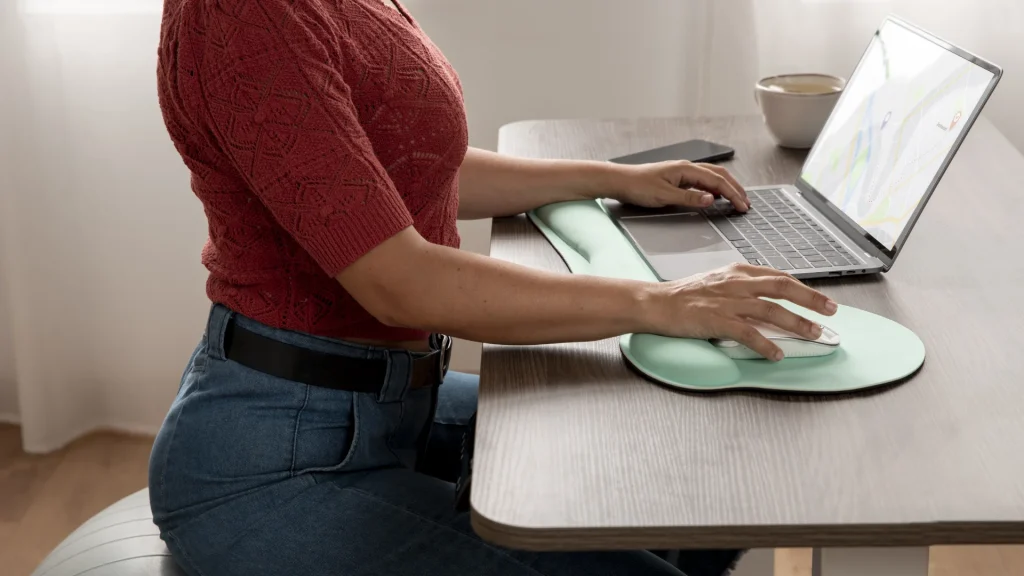Ergonomics for a Healthy Spine: Setting Up Your Workstation
In today’s digital world, more people than ever spend long hours working at a desk—whether in an office or at home. Unfortunately, poor workstation setup can lead to chronic issues such as lower back pain, neck strain, and poor posture. With the shift to remote work, the importance of a proper ergonomic workstation in Melbourne and beyond has never been greater. Simple adjustments to your desk setup can prevent back pain at work and promote long-term spinal health.

What Is Ergonomics and Why It Matters
Ergonomics is the science of designing a workspace to fit the user’s needs, reducing discomfort and the risk of injury. Proper office ergonomics can prevent:
- Lower Back Pain: Poor lumbar support and prolonged sitting can contribute to chronic pain.
- Neck and Shoulder Strain: Incorrect monitor height and poor posture can cause muscle tension.
- Carpal Tunnel Syndrome: Improper wrist positioning may lead to nerve compression.
- Headaches: Poor posture and screen glare can result in tension headaches.
Beyond preventing pain, an ergonomic workstation boosts productivity, enhances focus, and reduces fatigue, helping you feel and perform your best throughout the day.
Key Elements of an Ergonomic Workstation
Chair Setup
Your chair is the foundation of good posture. Choose a chair with proper lumbar support to maintain the natural curve of your spine. Adjust the height so that your feet are flat on the floor (or on a footrest if needed), your knees are at a 90-degree angle, and your lower back is supported to prevent slouching.
Desk Height
An incorrectly positioned desk can contribute to shoulder and wrist strain. The ideal desk height should allow for enough space underneath your desk for leg movement. Your forearms should be able to rest parallel to the floor, and your elbows should form a 90-degree angle while typing.
Monitor Placement
Your monitor setup is crucial for preventing neck strain at work. Position your screen so that the top of the monitor is at or slightly below eye level and the monitor is about an arm’s length away. If using dual monitors, both screens should be at equal height and placed side by side if used equally.
Keyboard and Mouse Position
Your hands should hover naturally above the keyboard, with your wrists straight. To optimise comfort, keep your keyboard and mouse close to avoid unnecessary reaching. Use an ergonomic keyboard and mouse for better wrist support, and consider a wrist rest to maintain a neutral hand position.
The Importance of Movement
Even the best ergonomic workstation in Melbourne won’t replace the need for movement. Prolonged sitting contributes to stiffness and discomfort, so it’s essential to stand or stretch every 30 minutes, take short walking breaks throughout the day, and perform simple desk exercises. Here are a few simple exercises and stretches you can do at your desk:
Neck Stretches
- Neck Tilt: Slowly tilt your head to one side, bringing your ear towards your shoulder. Hold for 10-15 seconds, then switch sides.
- Chin Tucks: Gently tuck your chin towards your chest and hold for a few seconds to stretch the back of your neck.
Shoulder and Upper Back Stretches
- Shoulder Rolls: Roll your shoulders forward and backward in circular motions to release tension.
- Upper Back Stretch: Clasp your hands together and push them forward, rounding your upper back to stretch between your shoulder blades.
Lower Back and Hip Stretches
- Seated Spinal Twist: Sit up straight, place one hand on the opposite knee, and twist your torso gently. Hold for a few seconds and repeat on the other side.
- Seated Hamstring Stretch: Extend one leg straight out and reach towards your toes for a gentle stretch.
Wrist and Hand Exercises
- Wrist Flexor Stretch: Extend one arm forward with the palm facing up, and gently pull the fingers back with your other hand.
- Finger Stretches: Open and close your hands repeatedly to improve circulation and prevent stiffness.
Leg and Foot Movements
- Seated Leg Extensions: Extend one leg straight out and hold for a few seconds before lowering it back down. Repeat with the other leg.
- Ankle Rolls: Rotate your ankles in circles to improve mobility.
Ergonomic Tips for Remote Workers
Not everyone working from home has access to an ideal office setup. Here are some budget-friendly solutions to improve posture and prevent back pain at work:
- Use books or boxes to elevate your monitor to eye level.
- Convert a regular table into a standing desk for better spinal alignment.
- Add a rolled-up towel or cushion for lumbar support if your chair lacks proper back support.
- Invest in a portable laptop stand and an external keyboard and mouse to avoid hunching over a screen.
Common Mistakes to Avoid
Even with the right desk setup for back pain prevention, small habits can negatively impact your spinal health. Avoid slouching or leaning forward towards the screen, and try not to cross your legs for long periods as that can misalign your hips and spine. If answering or making phone calls, instead of holding the phone between your shoulder and ear, use a headset or speakerphone instead. If you’re noticing early signs of discomfort, such as stiffness, headaches, or lower pain, don’t ignore them.
When to Seek Professional Help
If you experience persistent back or neck pain despite ergonomic adjustments, it may be time to consult a professional. Signs that include a more serious issue include:
- Numbness or tingling in the hands, arms, or legs.
- Sharp pain that worsens over time.
- Limited mobility or ongoing stiffness.
At Melbourne Spine Studio, we offer expert services, including posture assessments, spinal health consultations, and personalised treatment plans to help you achieve long-term relief.
Don’t let poor posture affect your health. If you’re experiencing persistent back or neck pain, Melbourne Spine Studio is here to help. Book a consultation today to receive personalised advice and expert care for a healthier spine.